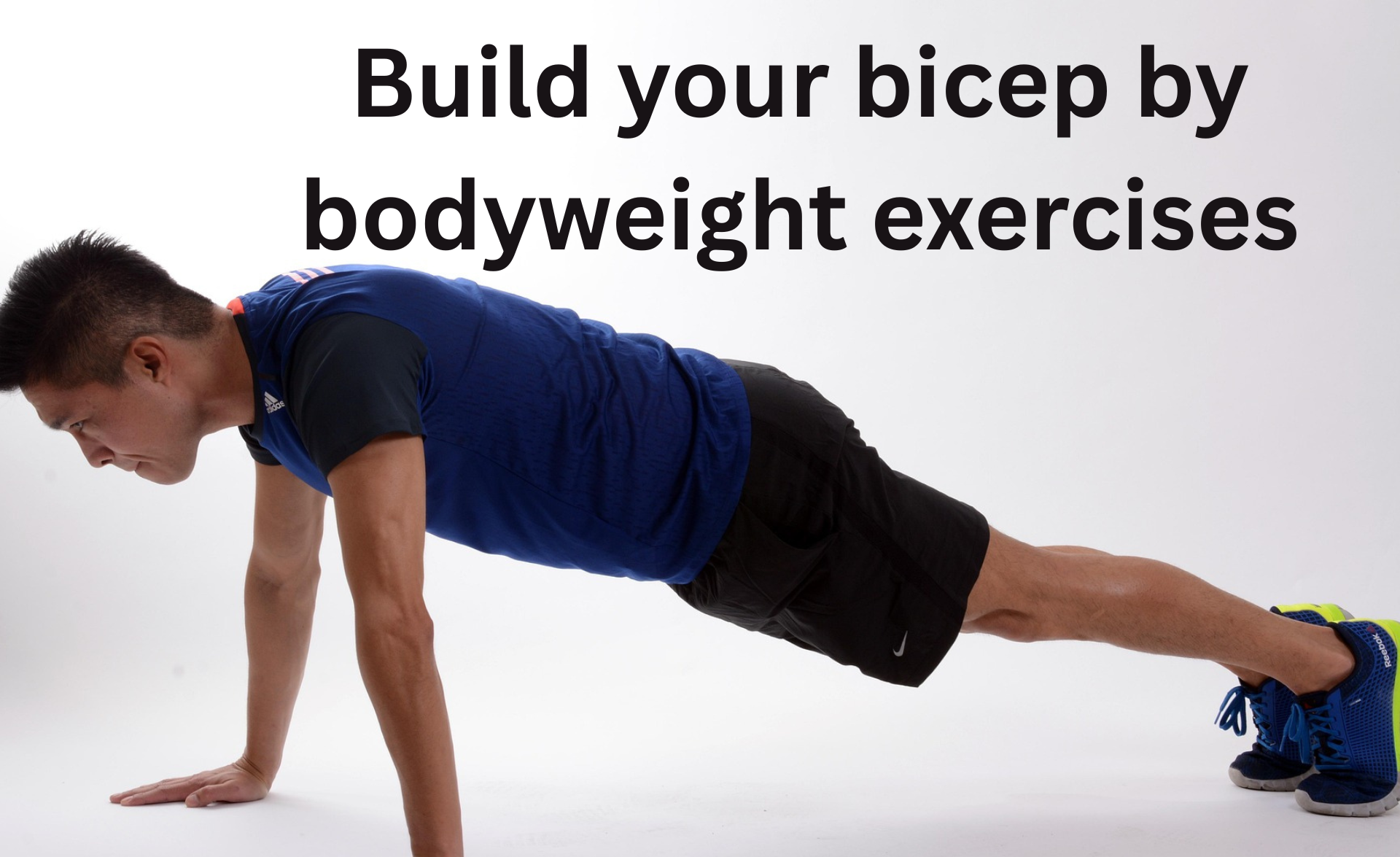If you’ve ever admired the full, rounded look of well-developed arms, you’re likely looking to improve your inner biceps. While most gym-goers focus on overall biceps curls, targeting the inner head of the biceps (also called the short head) is crucial for achieving that coveted peak and thickness. In this guide, we’ll break down how to work inner biceps effectively using science-backed techniques, expert tips, and high-impact exercises.
Understanding the Inner Biceps (Short Head)
Your biceps brachii consists of two heads:
- Long Head: Runs on the outside and contributes to biceps peak.
- Short Head (Inner Biceps): Located on the inside, closer to your chest. It adds width and thickness to your arms when viewed from the front.
Why Train the Inner Biceps?
Focusing on the inner head of the biceps can:
- Increase arm thickness
- Improve the aesthetics of flexed biceps
- Correct imbalances between biceps heads
- Boost your overall arm strength
How to Target the Inner Biceps (Training Mechanics)
To properly work the inner biceps, you need exercises that emphasize:
- A close grip or neutral (supinated) hand position
- Elbows in front of the torso
- Full range of motion with strict form
Top 7 Inner Biceps Exercises (In-Depth Guide)
These exercises are carefully selected to maximize short head biceps activation — giving your arms that dense, full look. Here’s a breakdown of how to perform each one effectively, including key cues, variations, and form tips.
1. Close-Grip Barbell Curl
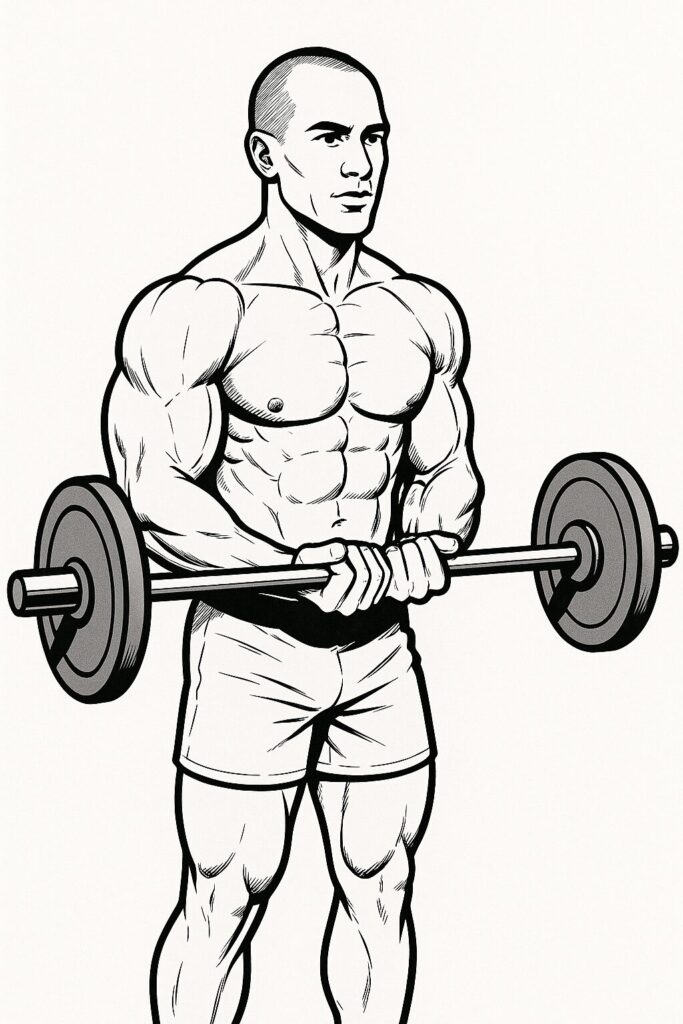
This classic exercise is often overlooked for short head development. The narrower grip places more tension on the inner biceps and helps build thickness.
How to Do It:
- Stand upright with feet shoulder-width apart.
- Grip a barbell with an underhand grip (palms up), hands placed closer than shoulder width.
- Keep elbows tucked in and avoid letting them flare.
- Curl the bar toward your shoulders slowly while squeezing the biceps.
- Pause at the top, then lower the bar under control.
Form Tips:
- Avoid swinging your back — keep your core engaged.
- Focus on a slow eccentric (negative) phase to increase time under tension.
- Use a barbell, EZ bar, or even a preacher curl machine with a narrow grip.
Reps/Sets:
3–4 sets of 8–10 reps
2. Preacher Curl (EZ Bar or Dumbbell)
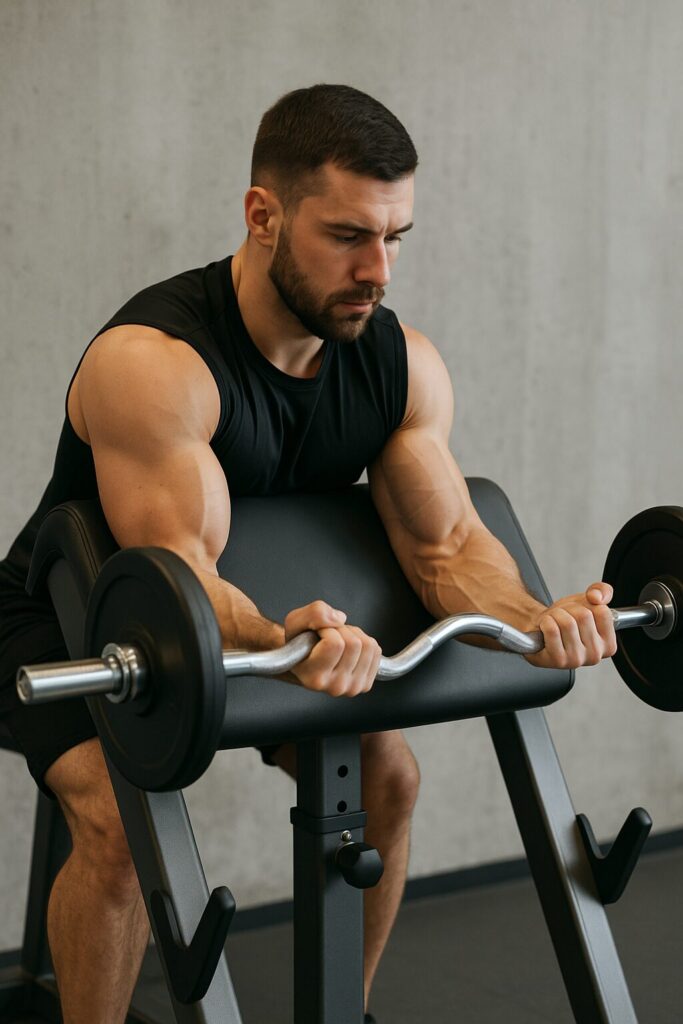
The preacher curl locks your elbows in place and prevents momentum, making it one of the best isolation exercises for the short head.
How to Do It:
- Sit at a preacher bench with your upper arms resting fully on the pad.
- Grab an EZ bar with a close grip (inside grip).
- Curl the weight toward your chin while keeping your elbows firmly on the pad.
- Slowly lower the weight back down, extending the arms fully.
Form Tips:
- Don’t let your shoulders roll forward at the bottom.
- Keep constant tension at the top — don’t let the bar rest.
- Dumbbells can be used one at a time for better mind-muscle connection.
Variations:
- Single-arm preacher curl (dumbbell)
- Machine preacher curl
- Cable preacher curl (for consistent resistance)
Reps/Sets:
3 sets of 10–12 reps
3. Spider Curls
Spider curls are great for maximizing the short head contraction since your elbows are positioned in front of your torso throughout the movement.
How to Do It:
- Set an incline bench at about a 45-degree angle.
- Lie chest-down on the bench with your arms hanging straight down holding dumbbells or an EZ bar.
- Curl the weights up slowly, focusing on squeezing your inner biceps.
- Pause and hold briefly at the top, then lower slowly.
Form Tips:
- Keep your upper arms perpendicular to the floor.
- Avoid swinging or jerking — strict control is key.
- Use lighter weights with high tension to maximize activation.
Variations:
- Cable spider curls (using low pulley)
- Reverse-grip spider curls for more forearm/bicep crossover
Reps/Sets:
3–4 sets of 12–15 reps
4. Concentration Curls
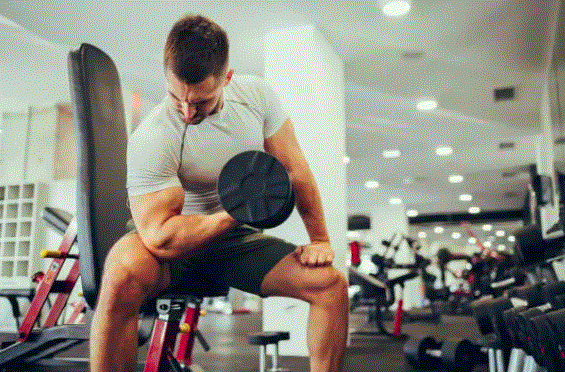
This is one of the best isolation movements for the inner biceps. It allows for a strong mind-muscle connection and a powerful squeeze at the top.
How to Do It:
- Sit on a bench with your legs spread apart.
- Hold a dumbbell in one hand and rest your elbow on the inner thigh.
- Curl the dumbbell slowly, turning your wrist (supinate) at the top for a stronger contraction.
- Squeeze at the top, then lower it under full control.
Form Tips:
- Focus on the pinky rotating upward at the top to maximize short head recruitment.
- Keep the movement strict — no shoulder or back movement.
- Use a mirror to monitor your form and focus on each rep.
Variations:
- Standing concentration curls (elbow resting on raised knee or bench)
- Cable concentration curl
Reps/Sets:
3 sets of 12 reps per arm
5. Chin-Ups (Close Grip)

Chin-ups aren’t just for your back — when done with a close, underhand grip, they massively engage the inner biceps.
How to Do It:
- Grab a chin-up bar with a shoulder-width or narrower underhand grip.
- Hang with arms extended and legs slightly bent.
- Pull yourself up until your chin is above the bar, squeezing your biceps.
- Lower slowly back to the dead hang position.
Form Tips:
- Keep chest up and shoulders down.
- Engage your lats as well — but focus on pulling with the biceps.
- Avoid kipping or swinging for cleaner, more effective reps.
Variations:
- Weighted chin-ups (for advanced lifters)
- Band-assisted chin-ups (for beginners)
- Isometric holds at top for maximum contraction
Reps/Sets:
3 sets of 6–10 reps
6. Cable Curls (High Pulley or Mid Pulley)
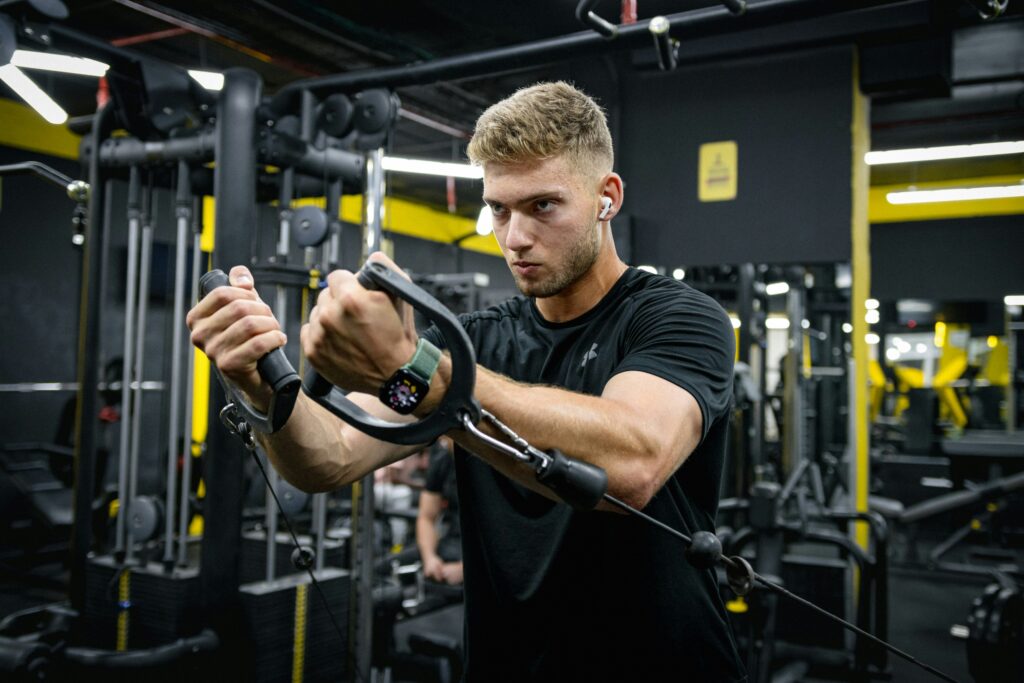
Cable curls are fantastic for keeping constant tension on the biceps throughout the movement, and the angle of the cable can emphasize different parts of the muscle.
How to Do It (Mid Pulley):
- Stand between two cable stacks set at mid-level.
- Grab D-handles with an underhand grip and arms extended out to sides.
- Curl both handles inward toward your ears while keeping elbows up.
- Pause and squeeze at the top, then return slowly.
Form Tips:
- Keep elbows elevated and still.
- Don’t let the weight stack touch down between reps.
- Focus on control and isolation — not heavy lifting.
Variations:
- Single-arm high cable curl
- Behind-the-body cable curl (Bayesian-style)
- Rope cable curls for a different grip angle
Reps/Sets:
3–4 sets of 12–15 reps
7. Bayesian Curl (Cable Curl with Elbow Behind)
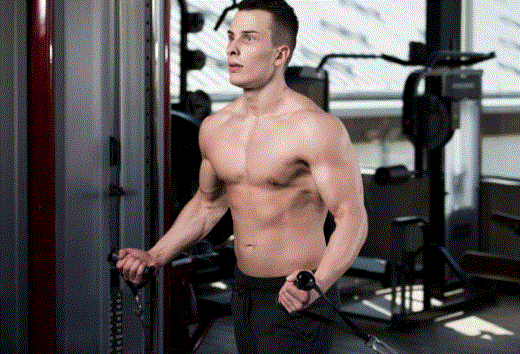
This advanced cable variation stretches the long head while working the short head effectively — especially when the arm starts behind the body.
How to Do It:
- Set a single cable pulley to the lowest setting.
- Stand a step forward so the cable pulls slightly behind your body.
- Hold the handle in one hand with your elbow behind your torso.
- Curl the weight forward while keeping tension on the biceps.
- Slowly lower back to the start with control.
Form Tips:
- Keep your chest up and shoulder back.
- Focus on the stretch at the bottom and contraction at the top.
- Maintain a full range of motion.
Variations:
- Seated Bayesian curls
- Cross-body Bayesian curls
Reps/Sets:
3 sets of 10–12 reps each arm
Sample Inner Biceps Workout Routine
Total Duration: 35–45 Minutes
| Exercise | Sets | Reps |
|---|---|---|
| Close-Grip Barbell Curl | 4 | 8–10 |
| Preacher Curl (EZ Bar) | 3 | 10–12 |
| Spider Curl (Dumbbell) | 3 | 12–15 |
| Concentration Curl | 3 | 12 |
| Cable Curl (Rope or Bar) | 3 | 15 |
Rest Time: 45–60 seconds between sets
Frequency: 1–2x per week depending on your split
Tips to Maximize Inner Biceps Gains
- Use Full Range of Motion: Don’t cheat your curls — stretch and squeeze fully.
- Focus on Mind-Muscle Connection: Feel the inner biceps contract during every rep.
- Avoid Swinging: Keep your form tight. No momentum.
- Progressive Overload: Increase weights slowly over time.
- Recovery: Let your arms rest at least 48 hours before hitting them again.
Mistakes to Avoid When Training Inner Biceps
- Only doing standard curls
These often target the long head more than the short head. - Using too much weight
This leads to poor form and reduced inner biceps activation. - Neglecting tempo and control
Slow, controlled reps lead to better gains than fast, sloppy movements.
Frequently Asked Questions (FAQs)
Q1: Can I really isolate the inner biceps?
You can’t completely isolate it, but you can emphasize the short head using specific grips and angles.
Q2: How often should I train inner biceps?
Twice a week is ideal — once heavy, once moderate with higher volume.
Q3: Do I need machines or can I train with dumbbells only?
You can definitely use dumbbells, but cables and machines help maintain tension and vary your routine.
Q4: Will training inner biceps improve my peak?
Yes, the short head contributes to fullness and the appearance of the peak when developed alongside the long head.
Conclusion: Build Bigger Inner Biceps Now
Targeting the inner biceps (short head) is essential if you’re aiming for fuller, thicker arms with an impressive peak. By using the right exercises — like close-grip curls, preacher curls, and spider curls — and focusing on proper form and mind-muscle connection, you’ll see noticeable results over time.
Whether you’re a beginner or advanced lifter, adding these inner bicep workouts into your routine can help sculpt strong, symmetrical arms that turn heads in and out of the gym.



